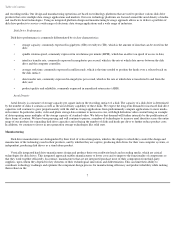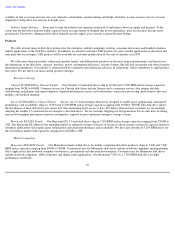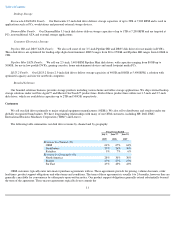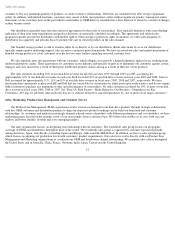Seagate 2008 Annual Report Download - page 8
Download and view the complete annual report
Please find page 8 of the 2008 Seagate annual report below. You can navigate through the pages in the report by either clicking on the pages listed below, or by using the keyword search tool below to find specific information within the annual report.
Table of Contents
needs. We believe that current growth opportunities for disk drives in traditional desktop computing applications lie primarily in developing
markets where price remains a primary consideration.
Higher capacity disk drives used in business critical applications are used to store less time-critical, but capacity-intensive data. Business
critical electronic data, which historically has been stored on tape or other backup and archival technologies, are now being stored on high
capacity disk drives because of decreases in cost per gigabyte.
Disk Drives for Mobile Computing. The mobile compute market consists primarily of disk drives used in notebook systems. Notebook
systems are increasingly becoming the preference over desktop computers for both consumers and enterprises as the need for mobility increases,
wireless adoption continues to advance, and price and performance continue to improve.
SSDs could become more competitive in the future in compute applications which require minimal storage capacity such as netbooks,
which are smaller, less powerful, less expensive, forms of mobile computers, and are slowly becoming a low-cost alternative to notebooks.
Disk Drives for Enterprise Storage. We define enterprise storage as disk drives used in mission critical applications which are defined by
the use of high performance, high capacity disk drives in applications that are vital to the operation of enterprises. We expect the market for
mission critical enterprise storage solutions to be driven by enterprises continuing to move network traffic to dedicated storage area networks. In
addition, as enterprises move away from the use of server-attached storage to network-attached storage and consolidate data centers to increase
speed and reliability within a smaller space, reduce network complexity and increase energy savings, this will lead to an increased demand for
more energy efficient, smaller form factor disk drives. These solutions are comprised principally of high performance enterprise class disk drives
with sophisticated firmware and communications technologies.
SSD storage applications have been introduced as a potential alternative to redundant system startup or boot disk drives. In addition,
enterprises are considering the use of SSDs in applications where rapid processing is required. The timing of significant adoption of SSDs in
these applications is currently unknown as enterprises weigh the cost benefits of mission critical enterprise disk drives relative to the perceived
performance benefits of SSDs.
Disk Drives for Consumer Electronics. Although flash memory solutions are contained in numerous consumer electronic devices, disk
drives in this market are primarily used in applications such as gaming and DVRs that require a higher capacity, more cost-effective storage
solution. We believe the demand for disk drives in CE will be driven by increased amounts of high definition content requiring larger amounts of
storage capacity.
Disk Drives for Branded Solutions. We define branded solutions as external disk drives sold in the retail channel. Disk drives used in
branded solutions are for purposes such as personal backup, portable data storage and to augment the consumer's current desktop or notebook
disk drive capacities. We believe the proliferation of media-rich digital content will continue to create increasing consumer demand for external
branded storage solutions. Our branded solutions disk drives are accounted for within our mobile and desktop compute markets.
Disk Drive Technology
Overview
The design and manufacturing of disk drives depends on highly advanced technology and manufacturing techniques and therefore requires
high levels of research and development spending and capital equipment investments. Manufacturing our disk drives is a complex process that
begins with the production of individual components and ends with a fully assembled unit. We design, fabricate and assemble a number of the
most important components found in our disk drives, including read/write heads
6





















